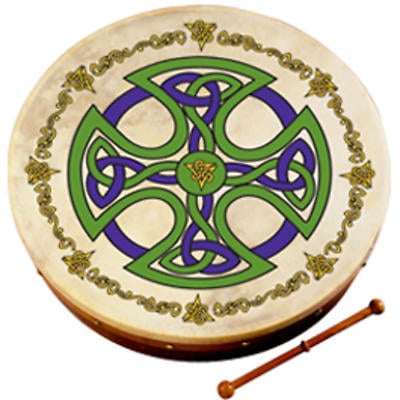The bodhran is a traditional Irish drum. If you like trad music, you have heard the bodhran. It’s pronounced bow (as in take a bow) ron (as in short for Ronald). Bodhran drums come in a range of sizes, from small souvenir ones that make nice Irish gifts to larger, tunable ones for serious musicians. They range from 8 inches to 18 inches.
These traditional Irish drums are flat, made of a wooden hoop frame with goatskin stretched over it. The round frame is typically made of birch or ash and features crossed wooden bars behind the goatskin to stabilize it and provide a handle. Bodhrans look a bit like large tambourines without the jingles. Players hold the drum with one hand on their leg and use a beater to play it. This beater is a short, wide drumstick, and both ends are used to hit the drum. It’s also called a cipin or a tipper. Some players prefer to use the back of their hand to beat the bodhran.
Bodhrans look as beautiful as they sound, which is why they are popular Irish gifts. The goatskin is usually painted. You can find bodhrans decorated with anything from swirling Celtic spirals to GAA county colors to family coats of arms. The decoration doesn’t diminish the sound, and professional bodhran players do use gorgeously painted drums.
History of the Bodhran
The earliest known reference to a bodhran is in a manuscript that dates back to the 15th or 16th century. Some scholars speculate that it was derived from drums that came from Africa via Spain, while others think it descends from Central Asian drums. We will never know it’s exact origins, but the bodhran was not originally used to make music. It was used more as a noise-maker. Celtic warriors pounded bodhrans as they went into battle, and people beat them at festivals. So people using them to cheer on their favorite football team are entirely in keeping with tradition!
Wren boys then used these drums on St. Stephens Day as part of those celebrations, but we didn’t see the bodhran take its place at the heart of Irish folk music until perhaps 100 years ago. They really took center stage in the 1960s. Trad legend Sean O Riada gets much of the credit for the rise of the bodhran in Irish music. Today, it just isn’t a proper trad session without a bodhran keeping the beat.
Bodhrans make great Irish gifts because they can be used as decoration or as a serious musical instrument – or both! They look stunning up on the wall, and sound great too. Find friends with a fiddle, a guitar and a tin whistle, and you’ve got the makings of a real session. Of course, they can also be used as noisemakers as the ancient Celts used them. No lessons required for that! Once upon a time, people also used them to sift grain, but hopefully those bodhrans didn’t have the kind of dazzling artwork that is now standard.

